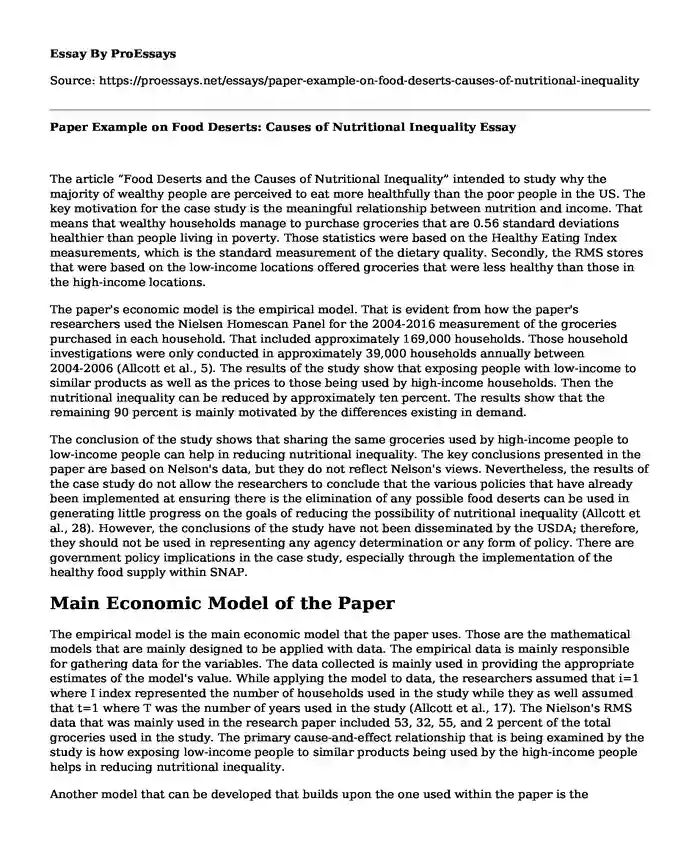The article “Food Deserts and the Causes of Nutritional Inequality” intended to study why the majority of wealthy people are perceived to eat more healthfully than the poor people in the US. The key motivation for the case study is the meaningful relationship between nutrition and income. That means that wealthy households manage to purchase groceries that are 0.56 standard deviations healthier than people living in poverty. Those statistics were based on the Healthy Eating Index measurements, which is the standard measurement of the dietary quality. Secondly, the RMS stores that were based on the low-income locations offered groceries that were less healthy than those in the high-income locations.
The paper's economic model is the empirical model. That is evident from how the paper's researchers used the Nielsen Homescan Panel for the 2004-2016 measurement of the groceries purchased in each household. That included approximately 169,000 households. Those household investigations were only conducted in approximately 39,000 households annually between 2004-2006 (Allcott et al., 5). The results of the study show that exposing people with low-income to similar products as well as the prices to those being used by high-income households. Then the nutritional inequality can be reduced by approximately ten percent. The results show that the remaining 90 percent is mainly motivated by the differences existing in demand.
The conclusion of the study shows that sharing the same groceries used by high-income people to low-income people can help in reducing nutritional inequality. The key conclusions presented in the paper are based on Nelson's data, but they do not reflect Nelson's views. Nevertheless, the results of the case study do not allow the researchers to conclude that the various policies that have already been implemented at ensuring there is the elimination of any possible food deserts can be used in generating little progress on the goals of reducing the possibility of nutritional inequality (Allcott et al., 28). However, the conclusions of the study have not been disseminated by the USDA; therefore, they should not be used in representing any agency determination or any form of policy. There are government policy implications in the case study, especially through the implementation of the healthy food supply within SNAP.
Main Economic Model of the Paper
The empirical model is the main economic model that the paper uses. Those are the mathematical models that are mainly designed to be applied with data. The empirical data is mainly responsible for gathering data for the variables. The data collected is mainly used in providing the appropriate estimates of the model's value. While applying the model to data, the researchers assumed that i=1 where I index represented the number of households used in the study while they as well assumed that t=1 where T was the number of years used in the study (Allcott et al., 17). The Nielson's RMS data that was mainly used in the research paper included 53, 32, 55, and 2 percent of the total groceries used in the study. The primary cause-and-effect relationship that is being examined by the study is how exposing low-income people to similar products being used by the high-income people helps in reducing nutritional inequality.
Another model that can be developed that builds upon the one used within the paper is the simulation model. The model is described as fundamentally mathematical, although the mathematical complexity involved with the model is transparent to the user. New research that an economist can conduct that builds upon the research of the economic paper is providing the low-income people with the groceries used by the high-income people while providing the high-income people with groceries used by the low-income people and determine the nutrient inequality was existing.
Work Cited
Allcott, Hunt, et al. "Food deserts and the causes of nutritional inequality." The Quarterly Journal of Economics, 134.4 (2019). https://academic.oup.com/qje/article-abstract/134/4/1793/5492274
Cite this page
Paper Example on Food Deserts: Causes of Nutritional Inequality. (2023, Sep 22). Retrieved from https://proessays.net/essays/paper-example-on-food-deserts-causes-of-nutritional-inequality
If you are the original author of this essay and no longer wish to have it published on the ProEssays website, please click below to request its removal:
- Social Welfare Services and Standards of Practice in the Health Care Provision
- Real Unemployment in Michigan Report
- Essay Example on Optimizing Daycare Staffing for Seasonal Variations
- Essay Example on Vaccination: Key to Disease Prevention & Survival
- Paper Example on HR: Maximizing Organizations' Success Through People
- Jonathan Lee, Experienced DNP, APRN & Medical Director of Primary Care Practice - Report Example
- Report on Exploring Pharmacology: Patient Outcomes, Safety, Community Impact, and Inequities in Access







